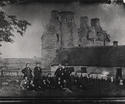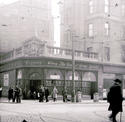Culture and Leisure
By John R Burnett
 As the 19th century progressed, working men and children had more leisure, as did young women without domestic responsibilities. Married women with children may have gained a little free time as the decades passed.
As the 19th century progressed, working men and children had more leisure, as did young women without domestic responsibilities. Married women with children may have gained a little free time as the decades passed.
Street Culture
 The street was the most important venue for working-class leisure. Standing and talking was an escape from the confinement of the single end, and there was always something to watch, something to see, even if it was just other people doing the same thing. Street entertainers, most often ballad singers or fiddlers, collected coppers, and street characters such as Hawkie (a wit) and Malabar (a juggler) were widely known because so many people spent their leisure hours on the streets.
The street was the most important venue for working-class leisure. Standing and talking was an escape from the confinement of the single end, and there was always something to watch, something to see, even if it was just other people doing the same thing. Street entertainers, most often ballad singers or fiddlers, collected coppers, and street characters such as Hawkie (a wit) and Malabar (a juggler) were widely known because so many people spent their leisure hours on the streets.
Rambling
 Leisure also involved escaping from the city. A tailor described how, around 1840, he left his work in Argyll Street at midnight on summer Saturdays. He walked out to watch the sunrise from the top of Cathkin Braes, "and drank in the hallowed beauty of the scene in the freshness of a Sabbath morning." Hugh MacDonald published his Rambles Round Glasgow in 1854, describing long walks with an extensive historical commentary, and other walkers were keen botanists and ornithologists. The typical walker was the intelligent working man who sought to exercise his intellect.
Leisure also involved escaping from the city. A tailor described how, around 1840, he left his work in Argyll Street at midnight on summer Saturdays. He walked out to watch the sunrise from the top of Cathkin Braes, "and drank in the hallowed beauty of the scene in the freshness of a Sabbath morning." Hugh MacDonald published his Rambles Round Glasgow in 1854, describing long walks with an extensive historical commentary, and other walkers were keen botanists and ornithologists. The typical walker was the intelligent working man who sought to exercise his intellect.
Holidays
 Holidays were fixed points in the calendar, not broad periods, and Glasgow Fair was the greatest leisure event of the year. It was held around the foot of the Saltmarket in mid-July. It expanded steadily from the late 18th century, and was at its peak in the 1840s. Then, as well as dozens of small shows there were also several large temporary theatres where drama (often condensed versions of Shakespeare concentrating on the bloodthirsty scenes) and magic were shown. It was last held in the Saltmarket in 1870.
Holidays were fixed points in the calendar, not broad periods, and Glasgow Fair was the greatest leisure event of the year. It was held around the foot of the Saltmarket in mid-July. It expanded steadily from the late 18th century, and was at its peak in the 1840s. Then, as well as dozens of small shows there were also several large temporary theatres where drama (often condensed versions of Shakespeare concentrating on the bloodthirsty scenes) and magic were shown. It was last held in the Saltmarket in 1870.
Racing
 Horse racing was the largest spectator event. Glasgow people went to Paisley, and to Stirling until racing ended there in 1854; but by then the railway made the meetings at Bogside (Irvine) and Ayr easier to reach. Paisley Races was a minor event until the 1820s but it then grew rapidly. It was said that the crowd in 1837 was 115,000, three years before the Glasgow & Paisley Railway opened, but many people went to picnic and drink, not to watch the horses. There were meetings at Airdrie between 1853 and 1870, and at Hamilton between 1888 and 1907. Paisley Races were last held in 1907: the (English) Jockey Club withdrew its licence as part of its campaign to reduce the number of racing venues by concentrating on courses which had good facilities.
Horse racing was the largest spectator event. Glasgow people went to Paisley, and to Stirling until racing ended there in 1854; but by then the railway made the meetings at Bogside (Irvine) and Ayr easier to reach. Paisley Races was a minor event until the 1820s but it then grew rapidly. It was said that the crowd in 1837 was 115,000, three years before the Glasgow & Paisley Railway opened, but many people went to picnic and drink, not to watch the horses. There were meetings at Airdrie between 1853 and 1870, and at Hamilton between 1888 and 1907. Paisley Races were last held in 1907: the (English) Jockey Club withdrew its licence as part of its campaign to reduce the number of racing venues by concentrating on courses which had good facilities.
Drinking
 Drinking was central to working class relaxation, particularly for men. In 1853 there were 2,053 public houses (one for every 170 inhabitants, regardless of age), but 1,261 (one for every 622) by 1912. This change partly reflects a lower level of alcohol consumption, but it also points to increasingly large public houses, the result of heavy investment in large, lavishly decorated premises and an interest in economies of scale. There were also 497 ice cream shops in 1912.
Drinking was central to working class relaxation, particularly for men. In 1853 there were 2,053 public houses (one for every 170 inhabitants, regardless of age), but 1,261 (one for every 622) by 1912. This change partly reflects a lower level of alcohol consumption, but it also points to increasingly large public houses, the result of heavy investment in large, lavishly decorated premises and an interest in economies of scale. There were also 497 ice cream shops in 1912.
Football
 Entertainment in the second half of the century was increasingly dominated by entrepreneurs. Though the first football club was the strictly amateur Queen's Park (1867), the growth of the game was fuelled by investors. As football became more commercial, owners of clubs were happy to allow tensions and enmities to develop between them because it increased the sizes of crowds. Soon crowds matched those at race meetings and football matches were held every week in winter whereas race meetings were held annually. Unlike racing, football spectators paid gate money. The Scotia Music Hall (1862) in Stockwell Street started a trend towards purpose-built music halls which were far larger than the earlier singing saloons, and no alcohol was sold in the Scotia. When the Theatre Royal, Hope Street, was rebuilt after a fire in 1879, it could seat as many as 4,000 people.
Entertainment in the second half of the century was increasingly dominated by entrepreneurs. Though the first football club was the strictly amateur Queen's Park (1867), the growth of the game was fuelled by investors. As football became more commercial, owners of clubs were happy to allow tensions and enmities to develop between them because it increased the sizes of crowds. Soon crowds matched those at race meetings and football matches were held every week in winter whereas race meetings were held annually. Unlike racing, football spectators paid gate money. The Scotia Music Hall (1862) in Stockwell Street started a trend towards purpose-built music halls which were far larger than the earlier singing saloons, and no alcohol was sold in the Scotia. When the Theatre Royal, Hope Street, was rebuilt after a fire in 1879, it could seat as many as 4,000 people.
Parks
 The Corporation was also a provider of leisure facilities. It bought the land for the West End Park (now Kelvingrove) in 1852, and by 1914 it owned twenty-two parks. In 1904 the first municipal bowling greens were laid out on the Green: ten years later there were thirty-five in various parks. The authorities provided bands which played in several bandstands in summer and in the Winter Gardens on the Green in winter.
The Corporation was also a provider of leisure facilities. It bought the land for the West End Park (now Kelvingrove) in 1852, and by 1914 it owned twenty-two parks. In 1904 the first municipal bowling greens were laid out on the Green: ten years later there were thirty-five in various parks. The authorities provided bands which played in several bandstands in summer and in the Winter Gardens on the Green in winter.
Doon the Watter
 The railway reached Greenock in 1840. This, and the increasing size of steamers sailing from the Broomielaw, meant that large numbers of Glaswegians could go doon the watter. In the 1850s, the number leaving the city on Fair Friday and Saturday was over 40,000, and in 1868 it passed 100,000. With time, an increasing proportion started by rail; only after effective sewage purification was introduced (1894) could a trip on the river be pleasant. Many of the Fair shows that had once been in the Saltmarket had already made for Gourock, Dunoon, and particularly Rothesay. Malabar, now known as Old Malabar, was juggling on the Esplanade at Rothesay in 1880 when he was 80.
The railway reached Greenock in 1840. This, and the increasing size of steamers sailing from the Broomielaw, meant that large numbers of Glaswegians could go doon the watter. In the 1850s, the number leaving the city on Fair Friday and Saturday was over 40,000, and in 1868 it passed 100,000. With time, an increasing proportion started by rail; only after effective sewage purification was introduced (1894) could a trip on the river be pleasant. Many of the Fair shows that had once been in the Saltmarket had already made for Gourock, Dunoon, and particularly Rothesay. Malabar, now known as Old Malabar, was juggling on the Esplanade at Rothesay in 1880 when he was 80.
Cosmopolitan Pleasures
In the 1850s, Glasgow was becoming part of the world market for élite culture. Giuliana Grisi and Giovanni Mario, two of the greatest singers in Europe, performed in Donnizetti and Bellini operas at the Theatre Royal, Dunlop Street, 1855. The American John Heenan and the Londoner Tom Sayers, who had just fought (and drawn) the first important international boxing match, came to the City Halls in 1860 where their sparring was admired by an audience of 7000, some of them respectable, others "Tontine loungers, Bridgegate rowdies, thieves, detectives &c." By the end of the century, the Glasgow comic W.F. Frame toured America, and American acts appeared in the Glasgow music hall. Glasgow, a west-facing seaport, was said to particularly favour American things, including ice-cold lager brewed locally. A few months after the first moving pictures were shown in Paris, they arrived in Glasgow. They were an attraction among the shows at Vinegarhill during the Fair and people talked of them on street corners.